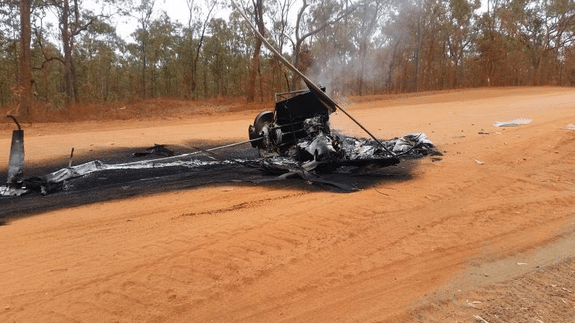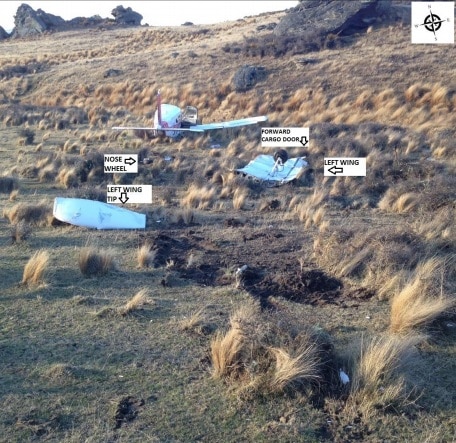Cow Takes Down Helicopter
Apologies to those who saw this on Fear of Landing’s Facebook and Twitter accounts, but I know many people only read the blog and I didn’t want anyone to miss it.
This is a Robinson R22 Beta which was dragged out of the air by a cow.

Well, no, it’s unfair to accuse the cow of ill-intent. The pilot was mustering the cattle when he must have flown too low. Apparently, the rails of the helicopter got tangled with the cow’s horns. The helicopter “lost its balance” and crashed. The pilot (and the cow) walked away with no injury but the helicopter caught fire and was totally destroyed.
However, if you watch this video by Outback Cattle Muster showing helicopter cattle mustering in progress, you’ll see why I think the cow could have been pulling the helicopter down on purpose.
I’m amazed at how fast and far the cattle can run. The pilot comments that they have “backpackers” helping on the ground, which is why some of the cattle/jeep conflicts happen. Watching it, it seems the helicopter really is the better option.
In a somewhat bizarre coincidence, yesterday the Transport Accident Investigation Commission (TAIC) of New Zealand has just released their report on a Piper PA32 which crashed on South Island in August of 2014.
The pilot was carrying out a stock-clearing manoeuvre to move cattle that were on the airstrip, and was in the process of turning the aeroplane around at low level to perform a second pass over the airstrip to scare the livestock away before landing, when the accident occurred.
The pilot turned downwind at low level for a second pass over the airstrip when he stalled the aircraft and crashed. The pilot was killed and two passengers were seriously injured.

…flying at close proximity to the ground requires a high degree of accuracy as there is little margin for error. It is important that pilots are fully aware of the stall characteristics of their aircraft, in particular how they are affected by manoeuvres such as steep turns. Pilots should also be aware of the effects of wind on the amount of ground covered during a turn
The aircraft operator believed stock clearing was permitted. The Civil Aviation Rules, however, do not define or refer to stock clearing and although they don’t specifically prohibit a pilot from carrying out a low approach and overshoot to clear animals off the runway, they do specify that an aircraft cannot be operated at an aerodrome unless the runway is clear of all persons, animals, vehicles and other obstructions.
However, in 2012, the CAA safety magazine specifically referred to stock-clearing manoeuvres in an article about low approach and overshoots.
The pilot involved in the incident was quoted as saying, “A low pass down the runway was accepted common practice as part of a go-around [low approach and overshoot]” and that “the rules didn’t prohibit the manoeuvre”. The published response from the CAA at the time was “just because the rules are silent on the matter doesn’t make it an acceptable practice”.
TAIC concluded that the situation regarding stock-clearing manoeuvres was not clear and it was up to the CAA to provide appropriate guidance as to whether it is a permissible activity.
More importantly, however, the pilot had never been trained for that type of low-level flying. The operator specified that if the stock didn’t move after one low-level pass, the pilots shouldn’t make further attempts. However, every pilot of the operator had a different view as to how the stock clearing should be carried out.
The pilot of the accident aeroplane carried out a modified low approach and overshoot, and instead of climbing out straight ahead after flying along the airstrip he turned at low level in order to make another low-level pass over the airstrip. In the absence of any specific guidelines from the operator or within the civil aviation system regarding stock clearing, the pilot carried out what he may have thought was an acceptable manoeuvre for stock clearing.
Entries in the pilot’s logbook, and the briefing he gave to the passengers about making “close passes” and “tight turns to get back around”, suggested this may have been his usual technique for clearing livestock that had not moved after the first pass.
I think the Australian mustering pilots and probably any crop-duster could have told him that he needed to get some altitude before turning for another pass.
You can read the full report here: Investigation 14-004 Piper PA32-300, ZK-DOJ, Collision with terrain, Near Poolburn Reservoir, Central Otago, 5 August 2014








What a bunch of … cowboys?
wrt your surprise at how fast cattle run — I’m surprised the rancher finds this a useful way of herding. A late friend who grew up on a cattle ranch (2.25 square miles in South Dakota) said the object was to get where a stray cow was quickly but then move the cow slowly, so it didn’t run off weight. Possibly the economics have changed enough since the 1940’s that weight losses and the huge cost of a helicopter (versus hands on quarter horses) can be recovered in a feedlot.
haha! It’s a version of cowboys to be fair. I have no idea if this is normal, of course. The fact that they get tourists taking part implies that it really isn’t.
Because some of the farms in Oz are as big as 5000 Square miles as opposed to 2.25 square miles, their herds can also be upwards 70,000 cattle simply a task that isn’t going to be managed on horseback.
my son a professional photographer lived in OZ fora number of years when he worked for Vogue OZ he took part in one or two of these round-ups and I understand the Ranchers are as mad as hatters as are the cows equaly so
We Aussies out here in OZ would indeed be mad as hatters if we were retarded ranchers, but we have huge cattle stations out here, not tiny ranches. Australia’s richest woman is about to purchase 67% of a cattle station worth $365 million and it’s bigger’n Texas by a longshorthorn..err..long shot.
Wow, good for her!! I think that is wonderful.
clearing stock I recall that when flying into Mull you had to do something simular overfly to scare the sheep but more often than not someone would appear and drive them off the grass strip, now the rams they were a different story
Haha, yes, I remember being told to always phone ahead at Mull so they could clear the sheep. I never actually saw them on the runway (thank goodness)
Badly flyblown rams aren’t scared if they sense in the slightest that you’re sheepish. You’ve gotta go at ’em right from the jump.
A New Zealander holidaying here in OZ told me that a helicopter pilot he knew back home would shoot game high up in the mountains and then tie them onto his chopper’s skids. He wouldn’t bother weighing them to ascertain if his chopper could lift them with a margin of safety, but just drag them off the side of the mountain, and if they were too heavy he’d quickly start to lose altitude until his buddy managed to cut one of the carcasses loose. Talk about living on the *edge*!
Sorry that you got locked up in moderation! I was travelling and only just got a chance to check the site. I’ve approved your email address so any further comments you make will be published directly.
And eeek!